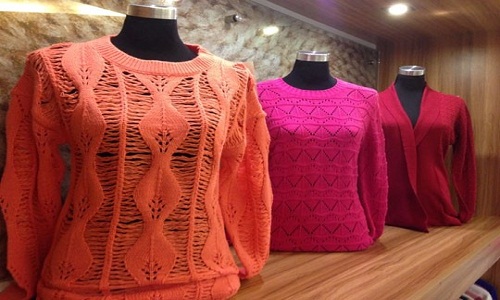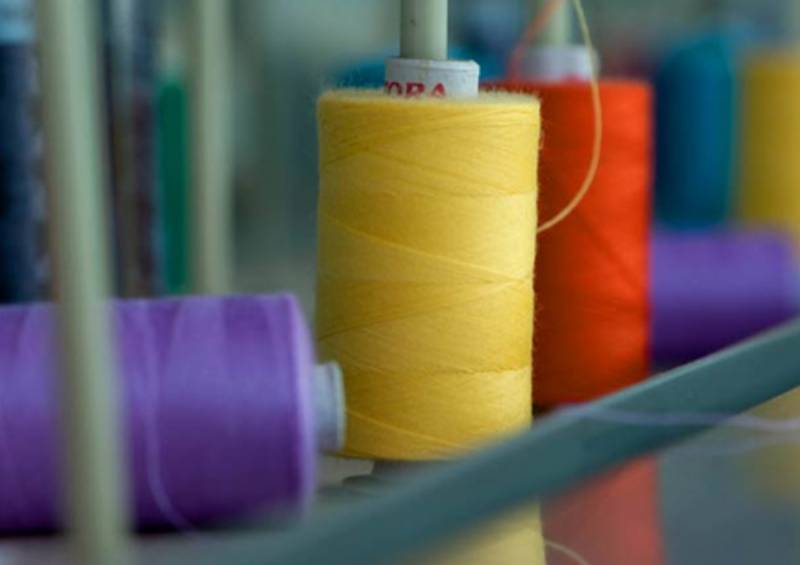FW
In the midst of the US-China trade dispute, Chinese companies will participate in Canada’s largest apparel and textile trade show, Apparel Textile Sourcing Canada (ATSC) to will be held from August 20-22, 2018 in Toronto. The show, featuring over 500 international exhibits, will include three days of seminars and panels, an on-site business matchmaking service and a spectacular fashion show spotlighting established and up-and-coming Canadian designers.
More than 5,000 visitors are expected to attend over the three-day event – now in its third year – including apparel and fashion executives, influencers, designers, retailers, importers, wholesalers, merchandisers, buyers and suppliers. ATSC is being supported by many international governments and associations, headed by the China Chamber of Commerce for Import and Export of Textile and Apparel (CCCT) and the Bangladesh High Commission on behalf of the Export Promotion Bureau and the Bangladesh Garment and Manufacturers Export Association.
The event is also being supported by the Taiwan Textile Association, the Federation of Indian Chambers of Commerce and Industry (FICCI), India’s Apparel Export Promotion Council (AEPC) and TFO Canada, experts in trade for developing countries.
Bangladesh targets a 6.33 per cent rise in readymade garment exports for fiscal 2018-19. Apparel occupies 83.79 per cent of the total exports. The target for knitwear is a rise of 7.21 per cent and woven growth target too is 7.21 per cent.
Cash incentive for garment exporters has been hiked to four per cent. With the higher cash incentives, garment exports to some new destinations like India, China, Japan and Australia are expected to grow a lot this year.
Bangladesh has had an impressive run in 2017-18 fiscal, making great strides in increasing garment exports. During the fiscal, apparel exporters marked a 8.76 per cent gain on a year-to-year basis – which is indeed encouraging in a competitive market where prices of apparel are falling.
Bangladesh targets readymade garment exports worth $50 billion by 2021. Buyer confidence in Bangladesh improved due to improvement in safety standards. However, manufacturers want a business friendly environment. They feel Bangladesh should focus on product diversification and go beyond the apparel sector and identify five sectors which would be able to earn over a billion dollars in the next five years. Bangladesh’s export earnings from readymade garment sector in the last fiscal year grew 8.76 per cent.
Ashapura Intimates’ Q1 net sales was, Rs 73.43 crores as compared to Rs 64.11 crores during the three month period ended June 30, 2017. Net profit stood at Rs 4.60 crores for the three month period ended June 30, 2018, as against Rs 3.99 crores for the three month period ended June 30, 2017.
Ashapura Intimates Fashion incorporated in 2006, is a fashion house that designs, brands, markets and retails intimate garments for men, women and children. The company is in the business of designing, branding, marketing and retailing clothing products such as lounge wear, sleep wear, bridal night wear, honeymoon sets, bathrobes, women’s inner wear, sportswear and kids’ lounge wear under the brand name Valentine.
Products across categories such as nighties, maternity feeding nighties and bridal night wear are marketed under the brand Night & Day. Their brand Valentine offers clothing that is comfortable, stylish and classy. The Valentine sportswear range is in 15 EBOs across India. The company plans to foray into the kids’ wear segment in the coming years.
"The industry attributes growth to expanding winter season in the western hemisphere as well as technological upgrades in manufacturing sweaters. Additionally, favourable conditions such as political stability and low cost funds are aiding the growth of sweater exports. In fact, industry leaders opine export growth could be even greater if there is enough logistical support at ports and in the transportation sector. They also hoped exports earnings will contribute $8 billion annually by 2021, if the government provides proper infrastructure and policy support."
 Data from the Bangladesh Export Promotion Bureau (EPB), for the fiscal 2017-18, reveals the country earned $3.67 billion in exports, which is 9.32 per cent higher than the $3.36 billion it earned in FY16-17. The country’s export earnings from sweater products grew 9 per cent to $3.67 billion in the last fiscal year. Sweaters contributed nearly 12 per cent to the total RMG exports of $30.61 billion of FY17-18.
Data from the Bangladesh Export Promotion Bureau (EPB), for the fiscal 2017-18, reveals the country earned $3.67 billion in exports, which is 9.32 per cent higher than the $3.36 billion it earned in FY16-17. The country’s export earnings from sweater products grew 9 per cent to $3.67 billion in the last fiscal year. Sweaters contributed nearly 12 per cent to the total RMG exports of $30.61 billion of FY17-18.
Growth drivers
The industry attributes growth to expanding winter season in the western hemisphere as well as technological upgrades in manufacturing sweaters. Additionally, favourable conditions such as political stability and low cost funds are aiding the growth of sweater exports. In fact, industry leaders opine export growth could be even greater if there is enough logistical support at ports and in the transportation sector. They also hoped exports earnings will contribute $8 billion annually by 2021, if the government provides proper infrastructure and policy support.
The second growth driver, according to the BGMEA is upgrading of manufacturing machines from manual to automatic. This has not only increased production capacity but also boosted worker productivity. Global climate change has also impacted Bangladesh with the winter season in the western hemisphere expanding beyond its normal period. This has increased demand for winter clothing.
automatic. This has not only increased production capacity but also boosted worker productivity. Global climate change has also impacted Bangladesh with the winter season in the western hemisphere expanding beyond its normal period. This has increased demand for winter clothing.
Shift in focus
Rising worker wages in China has led to manufacturers shifting their businesses to include higher-end products whereas buyers are searching for new sourcing destinations. Bangladesh offers a quality product at reasonable prices, this in turn, creates an opportunity for the country’s manufacturers.
Manufacturers say, global buyers are offering lower prices for their products, whereas the cost of production has gone up. To meet global demand, therefore they have to invest in automation, pushing production cost further up. However, the price of sweaters has not increased; rather, buyers have further reduced the prices of finished goods.
In order to grab a larger market share, Bangladesh has to increase port capacity to reduce lead-time. Inefficiency of infrastructure is another impediment that the country needs to be addressed. Bangladesh is unparalleled in product quality, so there is room to grow in the global market. However, there are challenges, including the lack of raw materials to produce high-end goods, technical expertise, and latest technology. Only about 60 per cent workers here can make higher-end products.
A stable and long-term policy, which would provide all out facilities to create a business friendly atmosphere, can pave the way to remove obstacles that stand in the way of new investments. The policy should be comprehensive and unified in order to ensure a level playing field for all.
For the first six months of 2018, Turkey’s apparel and clothing exports went up 7.7 per cent. The share of apparel and clothing exports in the country’s overall exports stood at 10.8 per cent. The share was 11.1 per cent for the first half of 2015, 12.3 per cent for the first half of 2016 and 10.7 per cent for the first half of 2017.
Turkey exports ready-to-wear apparel mostly to Germany, Spain and the UK followed by the Netherlands and France. For the first six months, the country’s apparel exports to Germany rose 7.2 per cent while exports to Spain rose 26.8 per cent. Turkey’s exports to the UK, increased 1.9 per cent.
Knitted garments were the most exported product group from Turkey in the first six months of 2018, increasing by 6.3 per cent. Woven apparel goods and accessories were the second most exported product group that saw an increase of 9.7 per cent. Exports of readymade goods, including home textile products, surged 7.6 per cent.
During the first six months, the unit prices for knitted apparel products fell 0.5 per cent from what they were in the first six months of 2017. Woven apparel unit prices increased 6.7 per cent.
Net sales of Vardhman Textiles during the three month period ended June 30, 2018, were Rs 1604.67 crores as compared to Rs 1525.69 crores during the three month period ended June 30, 2017. Net profit, was Rs 145.78 crores as against Rs 139.27 crores for same period last fiscal.
The company is one of the largest textile companies in India manufacturing cotton yarns and fabrics, constituting about two per cent of the country’s yarn production. The fabric processing capacity is 110 million meters a year. The product basket is diversified. It is now not only in cotton but creates blends like cotton tencel stretch, cotton modal super stretch and difficult products like bi-stretch.
Besides cotton yarn and blends, it is looking at more synthetic and blended yarns and is also taking steps to expand its existing fabric processing capabilities. Vardhman has improved its technology platform, so that its process automation, product quality and monitoring processes can be upgraded to deliver higher and better output.
Trade union representatives from Coimbatore have urged the Union textile minister Smriti Irani to resolve the payment issues faced by National Textile Corporation (NTC) mill workers. The seven NTC mills in Tamil Nadu employ around 1,400 regular workers. On May 31, 2018, the four-year wage agreement of these workers had expired. NTC workers recently sent a wage hike demand to its Southern Region office seeking a 50 per cent increase in basic wages and finalising the employment of workers who had worked for 480 days. It also sought Rs. 421 a day for casual workers.
The management had neither invited them for proper talks nor arrived at a solution, forcing the workers to hold demand meetings and wear demand cards to the mills. On August 7, a group of trade union leaders met the Union textile minister and sought her intervention. The minister assured them that necessary steps would be taken.
Net sales of Suryalakshmi Cotton Mills during the three month period ended June 30, 2018, was Rs 183.60 crores as compared to Rs 174.95 crores during the three month period ended June 30, 2017. Net profit, was Rs 0.54 crores as against Rs 0.52 crores for the three month period ended June 30, 2017.
Suryalakshmi has a denim fabric manufacturing capacity of 40 million meters a year. The company has launched new variants from the Amravati spinning unit to be used in manufacturing high-end denim fabrics. It has a capacity of 25,000 spindles for the manufacture of high quality value added and fancy yarns like stretch, slub and Elitwist yarns.
Suryalakshmi Cotton is one of India’s leading integrated premium yarn-to-denim-to-garment manufacturing companies. It has become the Original Denim Manufacturer to leading global and domestic brands with a dominant market share in the premium denim sector.
With cutting-edge designs, the latest spinning technology and end-to-end manufacturing plants, Suryalakshmi creates the finest yarns, premium denims and garments for leading private labels, fashion brands and retail chains in 31 countries across the globe.
As per a survey by the Bangladesh Institute of Bank Management (BIBM), shipment delays and late presentation of documents to Bangladesh's authorities are among the most critical challenges faced by the country's garment sector. The survey revealed around 66 per cent of exports could not be delivered on time while late presentation of documents, which poses a money laundering risk, occurred 53 per cent of the time. The main culprit was inadequate knowledge of domestic and international regulations.
The survey also dealt with the increasing amount of overdue export bills: 48 per cent against letters of credit (LCs) and 53 per cent against contracts. The bills increased sevenfold to $119.63 million last year from $16.23 million the year before. Around 42 per cent of export proceeds were found to have been non-repatriated against contracts.
BIBM study revealed the findings of the “Trade Facilitations in RMG by Banks: Risks and Mitigation Techniques” survey at a workshop.
The Philippines expects garment and textile exports to increase 10 to 20 per cent this year. Luxury bags brand Coach is expanding its existing four sourcing groups from the Philippines.
The US accounts for 67 per cent of the Philippines’ apparel exports including leather goods. In addition, the US also accounts for 27 per cent of the country’s textile, fiber and fabric exports.
What’s also helping Philippines is that some orders are being shifted from China to the Philippines to avoid the high tariffs imposed by the US on Chinese goods, including garments and textiles. One of the major hurdles Philippine exporters face is the Rules of Origin in Europe because even as the country enjoys EU GSP Plus, its textiles and fabrics are sourced elsewhere and are therefore slapped with higher taxes. EU GSP Plus, however, is expected to lead to more garment and textile investments in the country.
In addition, least developed countries enjoy zero duty when they export to the US as against the Philippines, which faces a 33 per cent duty on its garments, making Philippine garments more expensive than those from other countries.
Blouses from the Philippines have a tax of 12 per cent going to the US. Suits and blazers are at 33 per cent. The same products from LDC countries face zero duty.












